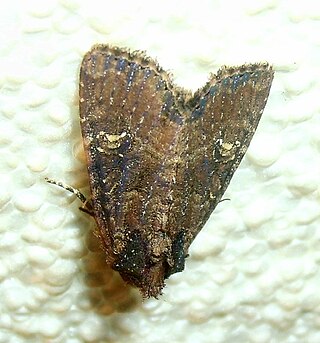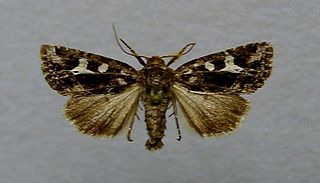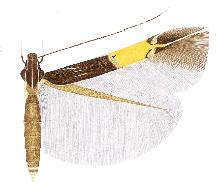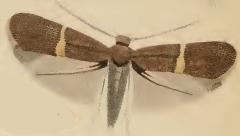
The large yellow underwing is a moth, the type species for the family Noctuidae. It is an abundant species throughout the Palearctic realm, one of the most common and most familiar moths of the region. In some years the species is highly migratory with large numbers appearing suddenly in marginal parts of the range.

Mythimna l-album, the L-album wainscot, is a moth of the family Noctuidae. The species was first described by Carl Linnaeus in his 1767 12th edition of Systema Naturae. It is distributed throughout Europe, but is also found in North Africa from Morocco to Tunisia and in the Levant, then east across the Palearctic to Central Asia. It is not found in the far north of the Arabian Peninsula. The limit in the north varies. It occurs on the northern edge of the range as a migrant. From southern England, then Denmark and southern Scandinavia, the north limit cuts across the Baltic Sea across the Baltic states then south of Moscow to the Urals.

Agriphila selasella is a species of moth of the family Crambidae. It was described by Jacob Hübner in 1813 and is found in Europe and east across the Palearctic.

Pyrausta despicata, the straw-barred pearl, is a species of moth of the family Crambidae. It was described by Giovanni Antonio Scopoli in his 1763 Entomologia Carniolica.

Mythimna pudorina, the striped wainscot, is a species of moth of the family Noctuidae. It is found in the Palearctic realm. Also Armenia, Asia Minor and eastern Siberia.

Cyclophora annularia, the mocha, is a moth of the family Geometridae. The species was first described by Johan Christian Fabricius in 1775 and it can be found in Europe.

Pachetra is a monotypic moth genus of the family Noctuidae erected by Achille Guenée in 1841. Its only species, Pachetra sagittigera, the feathered ear, was first described by Johann Siegfried Hufnagel in 1766. It is found in central and southern Europe, east to the Ural, north to southern England, Sweden and Finland. Southwards it is found from Anatolia, central Asia and the Altai up to Mongolia. It is also present in North Africa.

Ichneutica semivittata is a moth of the family Noctuidae. It is endemic to New Zealand and can be found from Three King Islands down to Stewart Island. The similar species I. sulcana can be distinguished from I. semivittata as the former is much larger, has a darker hindwing and abdomen and has only on to three spots located behind the middle of the forewing in comparison to the 8 or 9 of I. semivittata. This species lives in a variety of habitats from open grasslands to clearings in forest and at a range of altitudes from the sea level to the alpine zone. Larval host species include Juncus procera, Carex secta as well as on tussock grasses such as Poa cita, P. colensoi and Festuca novae-zelandiae. Adults of this species are on the wing from August to April and are attracted to light.

Mesapamea secalis, the common rustic, is a moth of the family Noctuidae. The species was first described by Carl Linnaeus in his 1758 10th edition of Systema Naturae. It is found in Europe, north-west Africa, Turkey and northern Iran.

Apamea unanimis, the small clouded brindle, is a moth of the family Noctuidae. The species was first described by Jacob Hübner in 1813. It is native to Europe, Turkey, Azerbaijan, and western Siberia. It has been introduced in North America and can now be found in Ontario, Quebec, New Brunswick, New York, Michigan, and Wisconsin.

Grammodes stolida, the geometrician, is a moth of the family Erebidae. The species was first described by Johan Christian Fabricius in 1775. It is found in Africa, southern Europe, most of Asia and Australia. It migrates to central and northern Europe as far north as England, Denmark and Finland.

Elachista freyerella is a moth of the family Elachistidae that is found in all of Europe, except the Balkan Peninsula. It is also found in North America.

Celaena haworthii, or Haworth's minor, is a moth of the family Noctuidae. The species was first described by John Curtis in 1829. It is found from the British Isles and France through northern Europe including Scandinavia, east to the Urals and across the Palearctic to Siberia and up to the Pacific Ocean.

Archanara dissoluta, the brown-veined wainscot, is a moth of the family Noctuidae. The species was first described by Georg Friedrich Treitschke in 1825. It is found in most of Europe, east into Russia and Siberia.

Cosmopterix damnosa is a moth of the family Cosmopterigidae. It is known from the United States.

Cosmopterix teligera is a moth of the family Cosmopterigidae. It is known from the United States, Brazil, Colombia, Costa Rica, Cuba, Jamaica and Mexico (Tamaulipas).

Elachista bisulcella is a moth of the family Elachistidae that is found in Europe.
Ardozyga haemaspila is a species of moth in the family Gelechiidae. It was described by Oswald Bertram Lower in 1894. It is found in Australia, where it has been recorded from New South Wales and South Australia.
Stachyneura sceliphrodes is a moth in the family Xyloryctidae. It was described by Edward Meyrick in 1925. It is found in Queensland, Western New Guinea and Papua New Guinea.

Ichneutica paraxysta is a moth of the family Noctuidae. It is endemic to New Zealand. This species is very similar in appearance to its close relative I. acontistis but as the range of the two species do not overlap this is unlikely to cause confusion. I. paraxysta is only found in the North Island at the subalpine zones in the Mount Taranaki region and at Mount Ruapehu. It prefers tussock grassland and shrubland habitat. The life history of this species is unknown as are the host species of its larvae however it has been hypothesised that the larval host plants are species in the genera of Poa and Festuca.
















